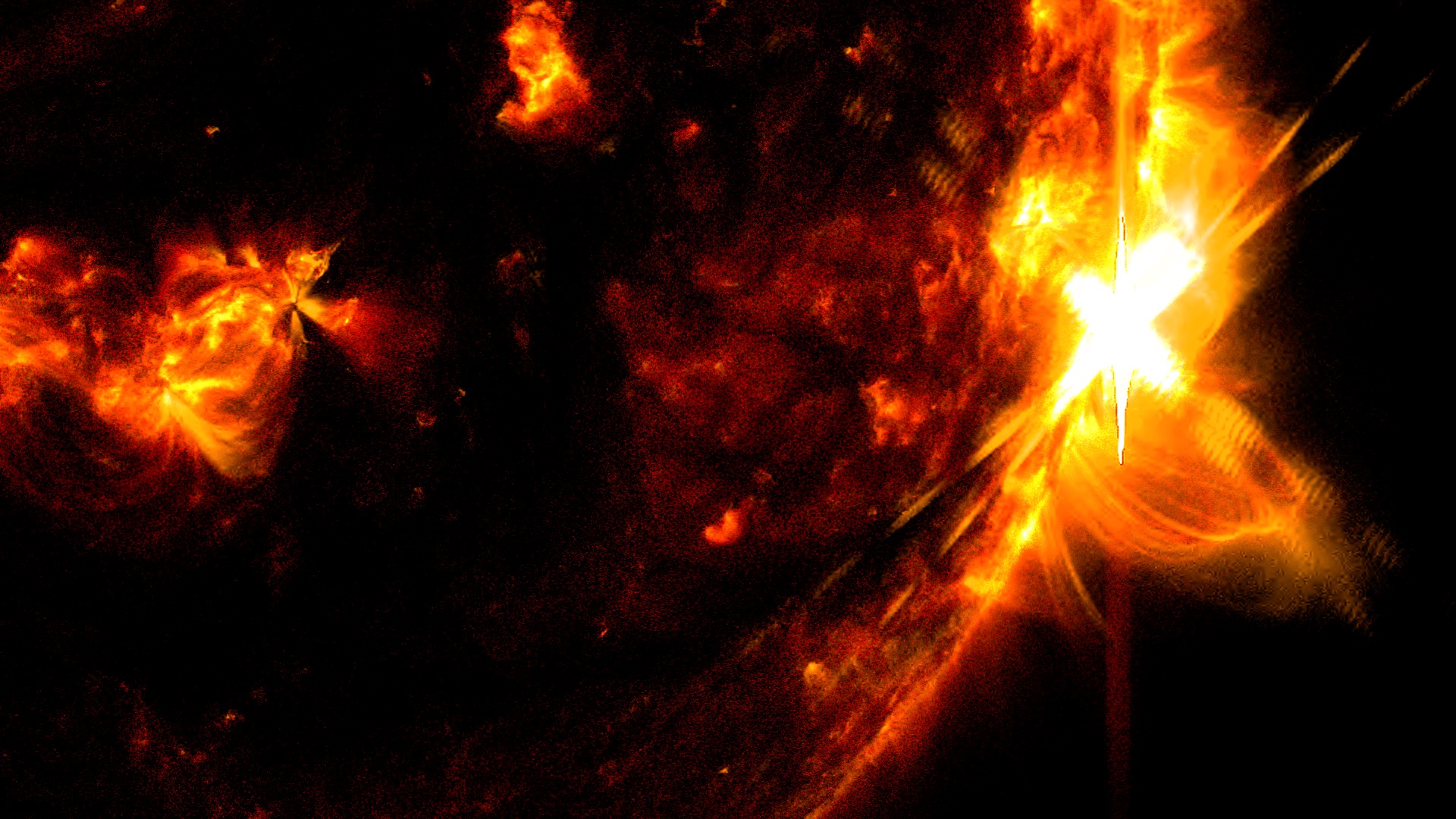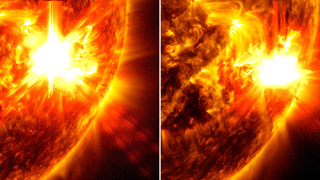Continuing Strong Solar Flares: May 15-16, 2024
During the week of May 10 to May 16, 2024, NASA’s Solar Dynamics Observatory (SDO) observed nine X-class solar flares erupting from the Sun, including the largest in this solar cycle to date on May 14 that peaked at X8.7.
This video shows these flares using SDO observations in two wavelengths of extreme ultraviolet light, 131 angstroms (colorized as teal) and 171 angstroms (colorized as gold).
These flares originated primarily from an active region on the Sun called AR 13664. This region, along with another called AR 13663, was responsible for the majority of strong solar flares from May 3 through May 9.
Watch this video on the NASA Goddard YouTube channel.
Music credit: "Collab Alert" by Ellis Kent [PRS] from Universal Production Music
NASA’s Solar Dynamics Observatory captured nine X-class solar flares between May 10-16, 2024. This video shows the Sun in extreme ultraviolet wavelengths (171 Ångstroms) colorized in gold. This wavelength of light highlights the extremely hot material in flares.
Additional flare imagery for May 10-14, 2024, can be found here: https://svs.gsfc.nasa.gov/14589/
Credit: NASA/SDO
NASA’s Solar Dynamics Observatory captured nine X-class solar flares between May 10-16, 2024. This video shows the Sun in extreme ultraviolet wavelengths (131 Ångstroms) colorized in teal. This wavelength of light highlights the extremely hot material in flares.
Additional flare imagery for May 10-14, 2024, can be found here: https://svs.gsfc.nasa.gov/14589/
Credit: NASA/SDO
NASA’s Solar Dynamics Observatory captured nine X-class solar flares between May 10-16, 2024. This video shows the Sun in extreme ultraviolet wavelengths (304 Ångstroms) colorized in red. This wavelength of light highlights the extremely hot material in flares.
Additional flare imagery for May 10-14, 2024, can be found here: https://svs.gsfc.nasa.gov/14589/
Credit: NASA/SDO

NASA’s Solar Dynamics Observatory captured this image of a solar flare – as seen in the bright flash on the right – on May 15, 2024. The image shows a blend of 131 Angstrom and 171 Angstrom light, subsets of extreme ultraviolet light.
Credit: NASA/SDO

NASA’s Solar Dynamics Observatory captured this image of a solar flare – as seen in the bright flash on the right – on May 15, 2024. The image shows a subset of extreme ultraviolet light that highlights the extremely hot material in flares and which is colorized in teal.
Credit: NASA/SDO

NASA’s Solar Dynamics Observatory captured this image of a solar flare – as seen in the bright flash on the right – on May 15, 2024. The image shows a blend of 171 Angstrom and 304 Angstrom light, subsets of extreme ultraviolet light.
Credit: NASA/SDO

NASA’s Solar Dynamics Observatory captured this image of a solar flare – as seen in the bright flash on the right – on May 15, 2024. The image shows 171 Angstrom light, a subset of extreme ultraviolet light.
Credit: NASA/SDO

NASA’s Solar Dynamics Observatory captured this image of a solar flare – as seen in the bright flash on the right – on May 15, 2024. The image shows the 193 Angstrom band of extreme ultraviolet light.
Credit: NASA/SDO

NASA’s Solar Dynamics Observatory captured this image of a solar flare – as seen in the bright flash on the right – on May 15, 2024. The image shows the 304 Angstrom band of extreme ultraviolet light.
Credit: NASA/SDO

NASA’s Solar Dynamics Observatory captured this image of a solar flare – as seen in the bright flash on the right – on May 15, 2024. The image shows a subset of extreme ultraviolet light that highlights the extremely hot material in flares and which is colorized in teal.
Credit: NASA/SDO
Credits
Please give credit for this item to:
NASA's Goddard Space Flight Center
-
Producers
- Scott Wiessinger (KBR Wyle Services, LLC)
- Lacey Young (KBR Wyle Services, LLC)
-
Data visualizer
- Tom Bridgman (Global Science and Technology, Inc.)
-
Writer
- Mara Johnson-Groh (Wyle Information Systems)
Release date
This page was originally published on Thursday, May 16, 2024.
This page was last updated on Monday, November 25, 2024 at 12:03 PM EST.



![Watch this video on the NASA Goddard YouTube channel.Complete transcript available.Music credit: "Neutral Motion" by Eric Chevalier [SACEM] from Universal Production MusicComplete transcript available.](/vis/a010000/a014600/a014688/Thumbnail01.jpg)